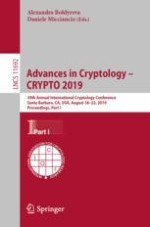2019 | OriginalPaper | Buchkapitel
Lattice-Based Zero-Knowledge Proofs: New Techniques for Shorter and Faster Constructions and Applications
verfasst von : Muhammed F. Esgin, Ron Steinfeld, Joseph K. Liu, Dongxi Liu
Erschienen in: Advances in Cryptology – CRYPTO 2019
Aktivieren Sie unsere intelligente Suche, um passende Fachinhalte oder Patente zu finden.
Wählen Sie Textabschnitte aus um mit Künstlicher Intelligenz passenden Patente zu finden. powered by
Markieren Sie Textabschnitte, um KI-gestützt weitere passende Inhalte zu finden. powered by
